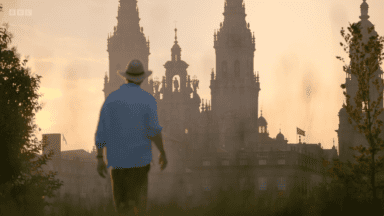
Admittedly somewhat enviously, but watching Monty Don roaming around imposing palaces, intriguing gardens and contemporary urban spaces in Spain was nothing less than a pleasure. Don’s enthusiasm and knowledge underpin the well researched programme, which puts the emphasis on the ‘culture’ in horti-culture.
In the first episode, Don travels across central Spain, beginning his journey at the vast Escorial before heading to Madrid, Toledo, other parts of Castile and finally, Valencia. With a generous palette of thought-provoking gardens, the series manages to shed light on the myriad of cultural influences that have shaped Spanish culture and gardens over the course of it’s rich history, right across its incredibly diverse landscape with varyingly challenging climates.
The first episode covered a series of interesting historical imperial palaces, domestic gardens, designed by passionate amateur gardeners as well as professional Spanish and International garden designers, ornamental-farm gardens, vast parks, urban landscapes and a really interesting selection of biophilic gardens in offices, schools and train stations. And of course, that garden designed by dogs – which sounds bonkers, but is a beautiful, dynamic garden that perhaps is a good lesson in how to effectively embrace change in our gardens.
At first glance, the programme manages to provide not only that welcome element of tv escapism, but more so, a valuable lesson in the requirement to working more closely with the landscape and coping with the challenges of the (harsh) climate. Compared to the harsh conditions gardeners in Spain experience on a daily basis, our gardens are spoilt. Rich in plant diversity – possibly too rich, but also fortunate in terms of much milder and more conducive climatic conditions. The latter is changing and seeing how gardeners and designers in Spain manage to create beautiful gardens in the harshest of conditions is a lesson to us all.
A few episode highlights:
- Dehesa de Yonte in Avila designed by Miguel Urquijo – Mediterranean and Castilian inspired garden on the edge of a reservoir with granite terracing, surrounded by native holm oaks, centenary olive trees, cypresses and its merged cohorts of shrub and perennial species. Irrigated for sure but beautifully integrated into its surroundings with its ‘natural’ selection of species.
- La Moraleja by Alvaro Sampedro in Madrid – A garden with dynamic and evolving spaces shaped by the meanderings of dogs, reflecting the passing of time and one that is in constant evolution.
- Reggio School in Madrid – Playful building featuring cork walls, concrete arches, porthole windows and zigzagging roofs. designed by architect Andrés Jaque that aims to be as colourful and playful as a child’s imagination. Planting of internal spaces such as the tropical atrium and the “green windows” throughout, completes the school’s unique educational ecosystem. A model for schools in the UK and around the world.
- Vertical garden in the Santander Bank in Madrid, designed by Luis Gonzalez-Camino. Covering almost 600 square metres with some 20,000+ plants from 25 different species, the towering garden rises up the eight floors of the building’s internal space. Outside, there are terraces planted with tropical plants. Originally created in 1975 as an integral part of the building, the vertical garden was designed to be a lush green garden for the benefit and wellbeing of the bank’s employees. Natural sunlight pours through the space via the glass ceiling, making it in effect a large greenhouse. This vertical garden is a good example of biophilic design, where the building is connected to the natural environment with its interior planting and views to the green world.
- Madrid Atocha Station – An atrium in the old part of the station now features an impressive botanical garden with more than 5,000 plants spanning 400 different species. The tropical garden is a quiet and relaxing space that offers an excellent counterpoint to the hustle and bustle of train stations.
- Granja Alnardo, Ribera del Duero, Spain – Designed by Tom Stuart-Smith for the celebrated wine maker Peter Sisseck. Fascinating large garden, very much an experiment in the making as the (local only) plants are pretty much left to their own devices and have to make do with no water, no chemicals, fertilisers or imported soil. Looking a tad bare as Don walked through it, but as Sisseck confidently explained the toughest plants will set seed and slowly populate the garden. Santolina, Rosemary and Euphoria seem to be coping and are forming elegant low mounds around the house and on the hill side.
- Un-named ruin garden in 15th century monastery in Toledo. Grandeur of the surviving structure, paired with the large, green planting is quite staggering. As Don points out the restraint of the planting adds to its beauty. Dramatic fusion of islamic and Christian history sits right at the heart of this and Spanish gardens. Shame it’s not open to the public as this is one to see.
Episode 2 of Monty Don’s Spanish Gardens will air on Thursday the 29th of February at 20:00 on BBC 2.

